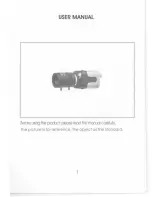
H-5
Ver. 1
H. DESCRIPTION OF MECHANISM
C-7070 Wide Zoom
[2] CP1 and VF1 CIRCUIT DESCRIPTION
1. Circuit description
1-1. Signal processor
1.
γγγγγ
correction circuit
This circuit performs (gamma) correction in order to main-
tain a linear relationship between the light input to the
camera and the light output from the picture screen.
2. Color generation circuit
This circuit converts the CCD data into RGB signals.
3. Matrix circuit
This circuit generates the Y signals, R-Y signals and B-Y
signals from the RGB signals.
4. Horizontal and vertical aperture circuit
This circuit is used gemerate the aperture signal.
1-2. AE/AWB and AF computing circuit
The AE/AWB carries out computation based on a 64-seg-
ment screen, and the AF carries out computations based
on a 6-segment screen.
1-3. SDRAM controller
This circuit outputs address, RAS, CAS and AS data for
controlling the SDRAM. It also refreshes the SDRAM.
1-4. SIO
This is the interface for the 8-bit microprocessor.
1-5. PIO/PWM/SIO for LCD
8-bit parallel input and output makes it possible to switch
between individual input/output and PWM input/output.
1-6. TG/SG
Timing generated for 7 million pixel CCD control.
1-7. Digital encorder
It generates chroma signal from color difference signal.
2. Outline of Operation
When the shutter opens, the reset signals (ASIC and CPU)
and the serial signals (Òtake a pictureÓ commands) from
the 8-bit microprocessor are input and operation starts.
When the TG/SG drives the CCD, picture data passes
through the A/D and CDS, and is then input to the ASIC as
12-bit data.
The AF, AE, AWB, shutter, and AGC value are computed
from this data, and three exposures are made to obtain
the optimum picture. The data which has already been
stored in the SDRAM is read by the CPU and color gen-
eration is carried out. At this time, correction of the lens
distortion which is a characteristic of wide-angle lenses
is carried out. After AWB and
γ
processing are carried out,
a matrix is generated and aperture correction is carried
out for the Y signal, and the data is then compressed by
JPEG and is then written to card memories (xD card and
CF card).
When the data is to be output to an external device, it is
taken data from the memory. When played back on the
LCD and monitor, data is transferred from memery to the
SDRAM, and the image is then elongated so that it is
displayed over the SDRAM display area.
3. LCD Block
LCD Block is in the VF1 board, and it is constructed by
LCD driver (IC171) and around circuits.
The video signal from the ASIC are converted into RGB
signals by the LCD driver, and these RGB signals and the
control signal which is output by the LCD driver are used
to drive the LCD panel. The RGB signals are 1H trans-
posed so that no DC component is present in the LCD
element, and the two horizontal shift register clocks drive
the horizontal shift registers inside the LCD panel so that
the 1H transposed RGB signals are applied to the LCD
panel. Because the LCD closes more as the difference in
potential between the COM (common polar voltage: AC)
and the R, G and B signals becomes greater, the display
becomes darker; if the difference in potential is smaller,
the element opens and the LCD become brighter.
4. Lens drive block
4-1. Shutter drive
The shutter drive signal (SIN1, SIN2) which is output from
the ASIC (IC101) is drived the shutter constant level driver,
and then shutter is opened and closed.
The shutter hold signal(VCTRL) which is output from the
ASIC (IC101) is restricted the shutter electric current. (main-
tenance electric current)
4-2. Iris drive
The iris stepping motor drive signals (IIN1, IIN2, IIN3 and
IIN4) which are output from the ASIC (IC101) are used to
drive by the motor driver (IC956), and carry out iris opera-
tion.
4-3. Focus drive
The focus stepping motor drive signals (FIN1, FIN2, FIN3
and FIN4) which are output from the ASIC (IC101) are used
to drive by the motor driver (IC956), and carry out focusing
operation. Detection of the standard focusing positions is
carried out by means of the photointerruptor (RPI) inside
the lens block.
4-4. Zoom drive
The zoom stepping motor drive signals (ZIN1 and ZIN2)
which are output from the ASIC (IC101) are used to drive by
the motor driver (IC956), and carry out zooming operation.
Detection of the zoom standard positions is carried out by
means of mecha switch (WSW) inside the lens block. Ac-
quisition of the zoom positions is carried out by means of
counting the photointerruptor (ZPI) inside the lens block.
Содержание CAMEDIA C-7070 Wide Zoom
Страница 1: ...Global Support Service Department OLYMPUS IMAGING CORP Ver 1 INDEX REPAIR MANUAL C 7070 Wide Zoom...
Страница 26: ...C 13 Ver 1 C ADJUSTMENT METHOD C 7070 Wide Zoom...
Страница 30: ...E 1 Ver 1 C 7070 Wide Zoom E NOTICE OF MODIFICATION...
Страница 31: ...F 1 Ver 1 C 7070 Wide Zoom F APPLICATION LIST OF GREASE AND CHEMICALS...
Страница 32: ...G 1 Ver 1 C 7070 Wide Zoom G SPECIAL JIGS AND TOOLS...
















































